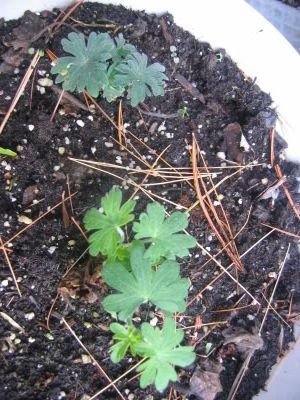A tale of two cuttings
OK, so it was actually two divisions, but I liked the snappy title. My apologies to Dickens. These two little plants were placed the same day in the same pot. One was a healthy little piece of the original plant, which had been snuggling up to a meadow rue and had to be moved to give them both more room. The other was the mother plant that had died back after greening up this spring, leaving its two daughters behind. No point in leaving a dead plant in the ground, I figured, so out it came. But when I pulled the brown stub up, the roots looked like they might still have some life in them, so I decided it was worth a try to save it.
These two little plants were placed the same day in the same pot. One was a healthy little piece of the original plant, which had been snuggling up to a meadow rue and had to be moved to give them both more room. The other was the mother plant that had died back after greening up this spring, leaving its two daughters behind. No point in leaving a dead plant in the ground, I figured, so out it came. But when I pulled the brown stub up, the roots looked like they might still have some life in them, so I decided it was worth a try to save it.
Now for reasons unknown to me, the healthy little offset has languished, turning rather more bluish than it was originally and, while it hasn't died, it has also not grown at all. The dead-looking stub has stayed dead-looking, but all around it is healthy new growth coming up from the roots.
The moral of this story? Don't be quick to decide a plant is dead. Gardening lore is filled with stories of uprooted plants flourishing in the compost heap, bulbs finally sprouting after two or three years of hiding underground, and plants "dying" in the summer, only to sprout happily the following spring.
The other thing I get out of this story is the ridiculous names that some plants are saddled with. This one, white bloody cranesbill a.k.a. Geranium sanguineum 'Album' is a prime example. The cranesbill part makes perfect sense; like all other plants in this genus, the seed pods are shaped like the bill of a crane. Some bright light decided that the purply pink flowers deserved the name 'bloody' though the only place you are likely to see blood that colour is in a Star Trek episode. When the white variety was developed or discovered, it couldn't be given a new name because it wasn't a separate species so 'White' was tacked on the front. Talk about a name designed by a committee! The Latin binomial just mirrors the whole process. And of course, "binomial" means "name with two parts" and this one has three...
Fortunately none of this matters when you admire the flowers and like kids in a sandbox, the plants don't ask each other about last names. They just play happily together.


No comments:
Post a Comment